14-2 Hubble devised a system for classifying galaxies according to their appearance
With large telescopes, millions of galaxies are visible across every unobscured part of the sky. Although all galaxies are made up of large numbers of stars, they come in a variety of shapes and sizes. Hubble classified them into four broad categories based on their appearance; this Hubble classification is a scheme that is still used today. The four classes of galaxies are the spirals, classified S; barred spirals, or SB; ellipticals, E; and irregulars, Irr. Table 14-1 summarizes some key properties of each class. These various types of galaxies differ not only in their shapes but also in the kinds of processes that take place within them.
| Spiral (S) and barred spiral (SB) galaxies | Elliptical galaxies (E) | Irregular galaxies (Irr) | |
|---|---|---|---|
| Mass (M⊙) | 109 to 4 × 1011 | 105 to 1013 | 108 to 3 × 1010 |
| Luminosity (L⊙) | 108 to 2 × 1010 | 3 × 105 to 1011 | 107 to 109 |
| Diameter (ly) | 15,000 to 800,000 | 3000 to 650,000 | 3000 to 30,000 |
| Stellar population | Spiral arms: young Population I Nucleus and throughout disk: Population II and the old Population I | Population II and old Population I | mostly Population I |
| Percentage of observed galaxies | 77% | 20%* | 3% |
| * This percentage does not include dwarf elliptical galaxies that are as yet too dim and distant to detect. Hence, the actual percentage of galaxies that are ellipticals may be higher than shown here. | |||
Spiral Galaxies: Stellar Birthplaces
M51 (Figure 14-1), M31 (Figure 14-2), and M100 (Figure 14-3) are examples of spiral galaxies. The spiral arms contain young, hot, blue stars and glowing hydrogen gas regions, indicating ongoing star formation.
Thermonuclear reactions within stars create metals, that is, elements heavier than hydrogen or helium. These metals are dispersed into space as the stars evolve and die. So, if new stars are being formed from the interstellar matter in spiral galaxies, they will incorporate these metals and be metal-rich Population I stars, similar to our Sun. Indeed, when we measure the visible-light spectrum of the disk of a spiral galaxy, we can see obvious absorption lines from metals. Such a spectrum is a composite of the spectra of many stars and shows that the stars in the disk are principally of Population I. By contrast, there is relatively little star formation in the central bulges of spiral galaxies, and these regions are dominated by old Population II stars that have a low metal content. This also explains why the central bulges of spiral galaxies have a yellowish or reddish color; as a population of stars ages, the massive, luminous blue stars die off first, leaving only the longer-lived, low-mass red stars.
Galaxies are classified by their spiral, elliptical, or irregular appearance.
Edwin Hubble further classified spiral galaxies according to the size of their central bulges and the appearance of their arms. Spirals with the largest and most obvious central bulges and tightly wrapped, smooth, broad spiral arms are called Sa galaxies, for spiral type a (Figure 14-5a); those with moderately well defined spiral arms and a moderate-size central bulge, like M81, are Sb galaxies (Figure 14-5b); and galaxies with narrow, well-defined but loosely wrapped spiral arms and a tiny central bulge are Sc galaxies (Figure 14-5c).

332
The differences between Sa, Sb, and Sc galaxies may be related to the relative amounts of gas and dust they contain. Observations with infrared telescopes—which detect the emission from interstellar dust—and radio telescopes—which detect radiation from interstellar gases such as hydrogen and carbon monoxide—show that about 4% of the mass of an Sa galaxy is in the form of gas and dust. This percentage is 8% for Sb galaxies and 25% for Sc galaxies.
Interstellar gas and dust is the material from which new stars are formed, so an Sc galaxy has a greater proportion of its mass involved in star formation than an Sb or Sa galaxy. Hence, an Sc galaxy has a large disk, where star formation occurs, and a small central bulge, where there is little or no star formation. By comparison, an Sa galaxy, which has relatively little gas and dust and thus less material from which to form stars, has a large central bulge and only a small star-forming disk.
Question
ConceptCheck 14-3: Where would you label more and less star formation when making a sketch of a spiral galaxy with considerable star formation?
Barred Spiral Galaxies: Spirals with an Extra Twist
 Go to Video 14-1
Go to Video 14-1
In barred spiral galaxies, such as those shown in Figure 14-6, the spiral arms originate at the ends of a bar-shaped region running through the galaxy’s nucleus rather than from the nucleus itself. As with ordinary spirals, Hubble subdivided barred spirals according to the relative size of their central bulge and the character of their spiral arms. An SBa galaxy has a large central bulge and thin, tightly wound spiral arms (Figure 14-6a). Likewise, an SBb galaxy is a barred spiral with a moderate central bulge and moderately wound spiral arms (Figure 14-6b), while an SBc galaxy has lumpy, loosely wound spiral arms and a tiny central bulge (Figure 14-6c). As for ordinary spiral galaxies, the difference between SBa, SBb, and SBc galaxies may be related to the amount of gas and dust in the galaxy.
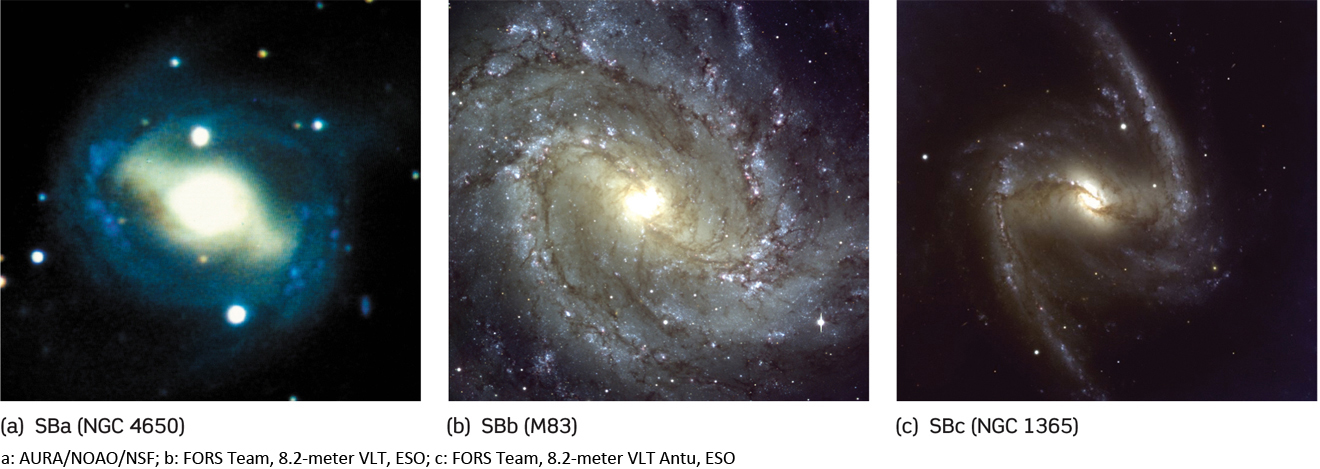
Bars appear to form naturally in many spiral galaxies. This conclusion comes from computer simulations of galaxies, which set hundreds of thousands of simulated “stars” into orbit around a common center. As the “stars” orbit and exert gravitational forces on one another, a bar structure forms in most cases. Indeed, barred spiral galaxies outnumber ordinary spirals by about two to one.
Question
ConceptCheck 14-4: How are galaxies with loosely wrapped arms categorized using Hubble’s scheme?
Elliptical and Irregular Galaxies
Elliptical galaxies, so named because of their distinctly elliptical shapes, have no spiral arms. Hubble subdivided these galaxies according to how round or flattened they look. The roundest elliptical galaxies are called E0 galaxies and the flattest, E7 galaxies. Elliptical galaxies with intermediate amounts of flattening are given designations between these extremes (Figure 14-7).
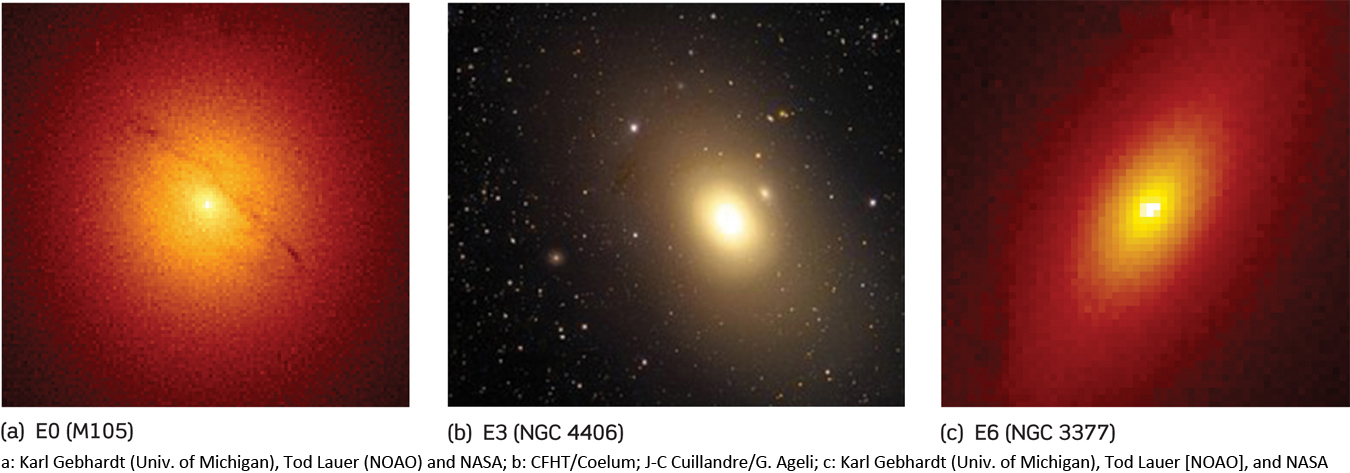
CAUTION
Unlike the designations for spirals and barred spirals, the classifications E0 through E7 may not reflect the true shape of elliptical galaxies. An E1 or E2 galaxy might actually be a very flattened disk of stars that we just happen to view face-on, and a cigar-shaped E7 galaxy might look spherical if seen end-on. The Hubble scheme classifies galaxies entirely by how they appear to us on Earth.
333
Elliptical galaxies look far less dramatic than their spiral and barred spiral cousins. The reason is that ellipticals have virtually no interstellar gas and dust. Consequently, there is little material from which stars could have recently formed, and indeed there is no evidence of young stars in most elliptical galaxies. For the most part, star formation in elliptical galaxies ended long ago. Hence, these galaxies are composed of old, red, Population II stars with only trace amounts of any metals.
Elliptical galaxies come in a wide range of sizes and masses. Both the largest and the smallest galaxies in the known universe are elliptical. Figure 14-8 shows two giant elliptical galaxies that are about 20 times larger than an average galaxy. These giant ellipticals are located near the middle of a large cluster of galaxies in the constellation Virgo.
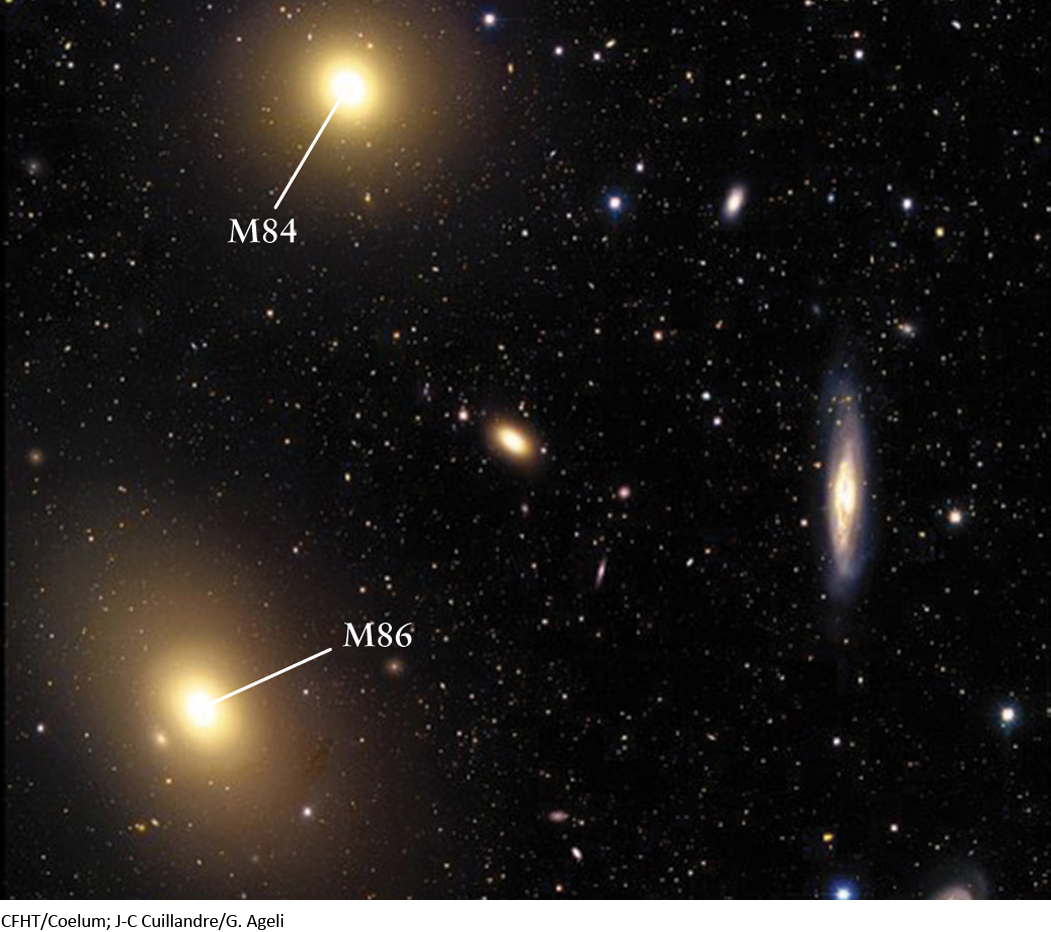
Giant ellipticals are rather rare, but dwarf elliptical galaxies are quite common. Dwarf ellipticals are only a fraction of the size of their normal counterparts and contain so few stars—only a few million, compared to more than 100 billion (1011) stars in our Milky Way Galaxy—that these galaxies are completely transparent. You can actually see straight through the center of a dwarf galaxy and out the other side, as Figure 14-9 shows.
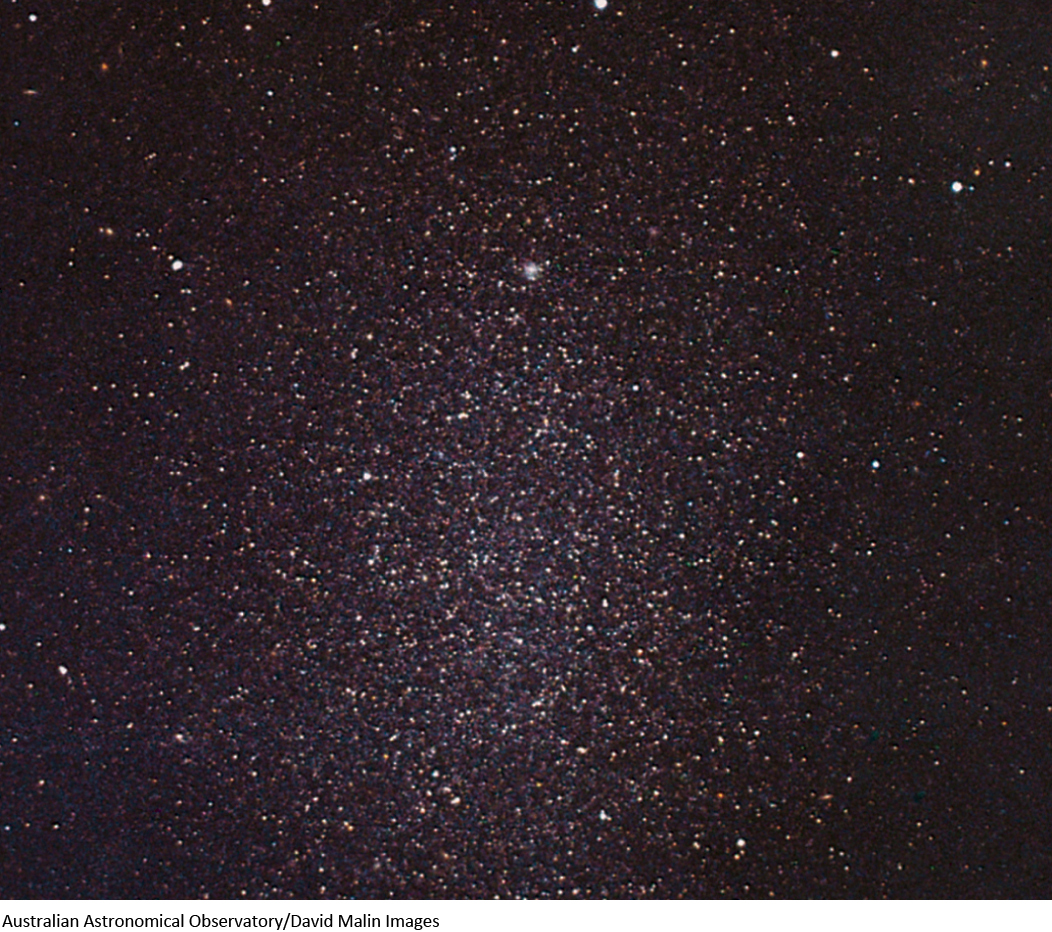
Hubble also identified galaxies that are midway in appearance between ellipticals and the two kinds of spirals. These are denoted as S0 and SB0 galaxies, and are also called lenticular galaxies. Although they look somewhat elliptical, lenticular (“lens-shaped”) galaxies have both a central bulge and a disk like spiral galaxies, but no clear spiral arms. They are therefore sometimes referred to as “armless spirals,” mostly because we are seeing them edge-on. Figure 14-10 shows an example of an S0 (pronounced “esszero”) lenticular galaxy.
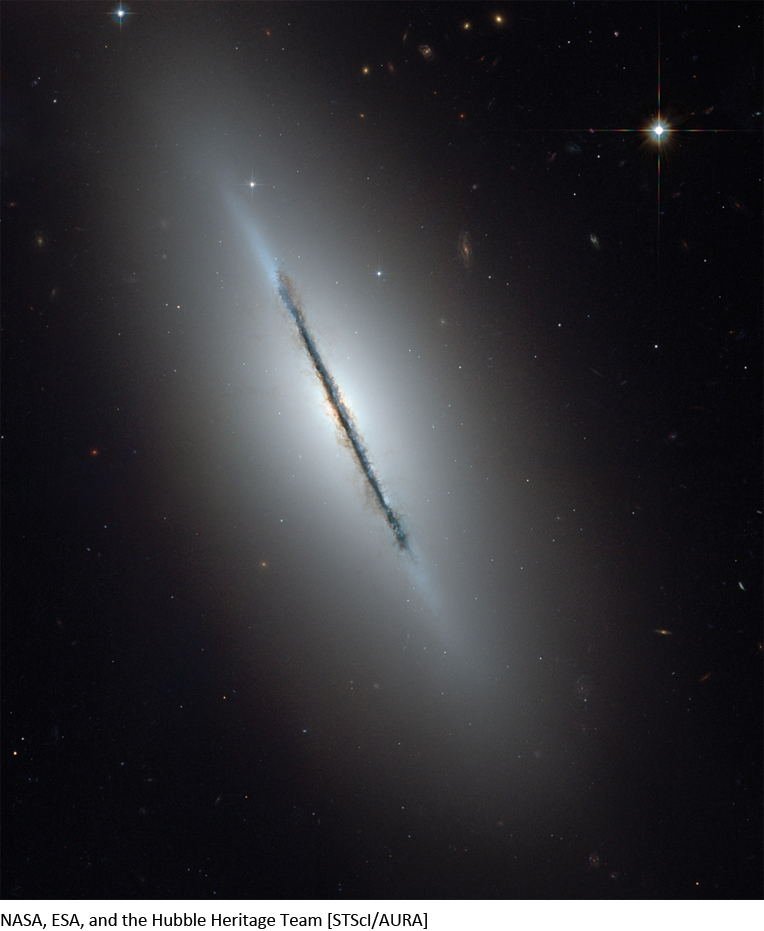
334
Hubble summarized his classification scheme for spiral, barred spiral, and elliptical galaxies in a diagram, now called the tuning fork diagram for its shape (Figure 14-11).
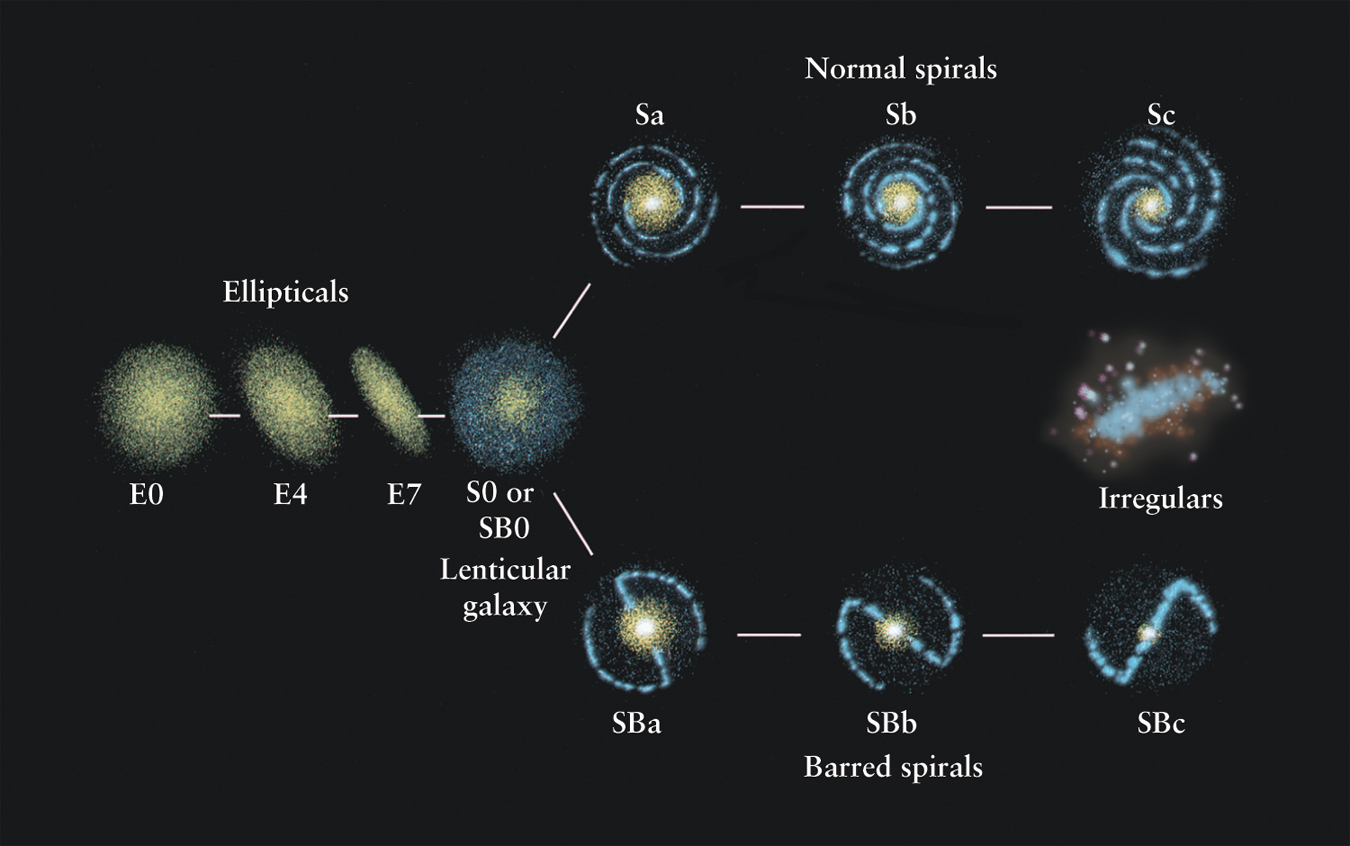
CAUTION
When Hubble first drew his tuning fork diagram, he was thinking that it might represent an evolutionary sequence of galaxy formation and evolution. He thought that galaxies evolved over time from the left to the right of the diagram, beginning as ellipticals and eventually becoming either spiral or barred spiral galaxies. We now understand that this is not the case at all! For one thing, elliptical galaxies have little or no overall rotation, while spiral and barred spiral galaxies have a substantial amount of overall rotation. There is no way that an elliptical galaxy could suddenly start rotating, which means that it could not evolve into a spiral galaxy.
Finally, galaxies that do not fit into the scheme of spirals, barred spirals, and ellipticals are conveniently referred to as irregular galaxies. They are generally rich in interstellar gas and dust, and have both young and old stars. For lack of any better scheme, the irregular galaxies are sometimes placed between the ends of the tines of the Hubble tuning fork diagram, as in Figure 14-11.
Question
ConceptCheck 14-5: Which type of galaxy has almost no ongoing active star formation?